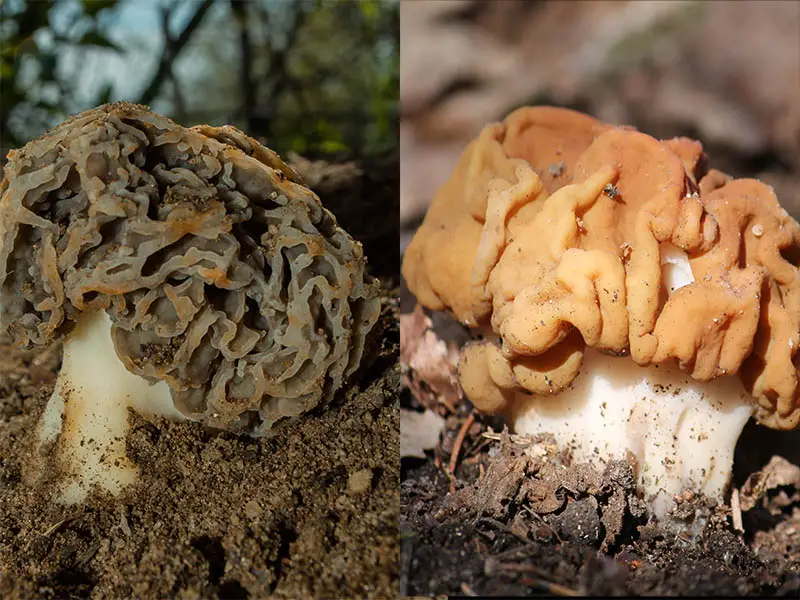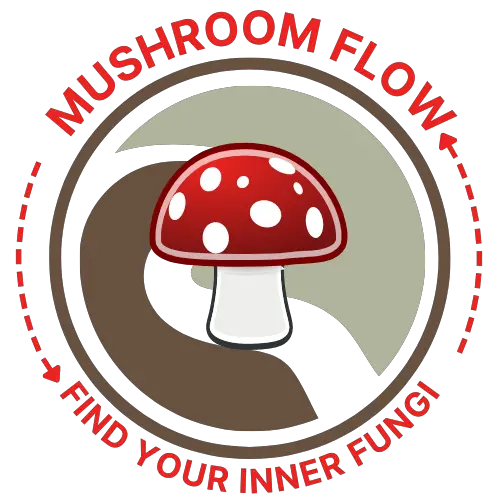With so many look-alike mushrooms, it can be daunting to tell edible and poisonous morels apart. Thankfully, morel mushrooms have distinctive characteristics that help delineate a real morel from a false morel.
The cap of a real morel is rigid, with a pitted honeycomb pattern and the top to the lower edge is pointed. Upon cutting a true morel, you’ll find a hollow interior atop a hollow stem. A true Morel has no ring, veil, or gills and the vast majority are longer than wide. A false morel is wide and stumpy with ridges instead of pits.

What is the Difference Between a Real Morel and a False One?
It’s important to learn about morel mushroom look-alikes because some are toxic. For example, one called a Brain Mushroom, or Elephant Ear Mushroom (Gyromitra esculenta) can be deadly, even after cooking. The Brain Mushroom is among the ones that cause the most fatalities annually. Its stem is not hollow, and it has a folded reddish, dark brown, or purplish-brown cap, looking wrinkled and folded.
Another deceptive fungus is an Early False Morel mushroom (Verpa bohemica). It’s nowhere near as toxic as the Brain mushroom but is likely to make you rather sick. The Early False Morel has a filled stem and a cap hanging free from the stem.
Tip: A real morel cap is pitted inward, while a false morel has outward-bulging caps. Plus, true morels are found in the spring, not other times of the year.
Then there’s Gyromitra caroliniana, the Carolina False morel (nicknamed big red). The Caroline false morel lives in the southeastern United States in hardwood forests. They begin popping out right after the final thaw and grow to HUGE sizes (8” tall, 5” wide).
Gyromitra infula, the hooded false morel, follows the pattern of having a darkish red-brown cap. This one is tricky since there are some hollow chambers within. This fungus lives in the Northern Hemisphere, thriving from later summer to autumn. Some say if you cook this mushroom, the toxins may be removed. It’s not recommended as an experiment.
Finally, the Bell morel (Verpa conica) grows early, but the cap looks like a thimble. Plus, the cap is freely attached, whereas a true morel cap attaches at the base. The center of the Bell morel has cotton-like material, too. In terms of eating, caution is highly advised.
How to identify True and False Morels?
False morels grow near the ground, sometimes on wood. Later in the year, it’s less likely for people to make a mistake since true Morels are past peak season. False morels have light-colored stems (whitish to tan).
False morels thrive where there is decaying or dead organic matter and where the forest soil and plants have been disrupted are the ideal growing grounds for false morels. Other tips include:
- Remember, the true morel has a honeycombed cap exhibiting tiny pits rather than wavy.
- True morels have a cap attached to the stem, whereas the false ones hang freely from the stem.
- Hollowness is a huge clarifier. When you slice a true morel, it’s hollow inside. There will be no fuzzy fibers.
Where do Real and False Morel Mushrooms Grow?
If you are a forager, you may wonder how best to hunt for morels. There is a website that can get you started called The Great Morel, where people share successful spots. You can also find a map on the site.
Generally speaking, you are looking for ash, aspen, elm, and oak trees, especially dead ones where leaves and other debris lay. The base of a dying tree is a prime location. Look at the ground they sprout right there.
If there’s a region where there was a forest fire within the last years, morels love these spots. Avoid any smushy soil, they don’t like their dirt soggy. When you find one or two, you’re likely to find more nearby. Search a 20-food diameter and gather what you can. To harvest just cut the base with a knife or scissors.
The best stomping ground for your search includes the states of Arkansas, Maryland, North Carolina, Oklahoma, Kentucky, Tennessee, and Virginia.
Morels in the Midwest
Illinois and Missouri see their fair share of Morels. They begin fruiting when the temperature reaches 60-70 degrees by day (mid-Mayish) and no lower than 50F by night. Once they begin, there’s about a three-week period for finding them.
Northeastern Morels
The Northeast suffers somewhat from a lack of morels but for parts of Massachusetts. They do show up from time to time near dying elms and apple trees. Should you stumble across some Velvet Shank mushrooms (Flammulina velutipes) in early winter, return to that spot come spring to see if morels are there.
Heading West
Among the stars in the mushroom world, the western coast is beloved for its morel season. The fungus thrives in old burn sites. Northern California, Washington, Oregon, and Montana all yield excellent results (like pounds instead of ounces!).
Final Thoughts: The Morel of the Story
After diligently finding your true morels (or more easily shopping for them) it’s time to eat. Like all wild mushrooms, consuming them benefits you, offering vitamins, minerals, and fiber.
Before looking at recipes, it cannot be stressed enough that morel mushrooms are not really best for raw consumption. It would be best if you cooked them to avoid upset tummies. No worries. There are plenty of ways to use them in your kitchen adventures.
- Morels are a savory addition to soups and sauces.
- Sautee them in butter
- Deep fry them
- Toss them in pasta
- Use as a pizza topper
- Asparagus and morels in garlicky cheese sauce
- Stuff them with crab, then wrap them in bacon
- Turn them into a quiche
- Add to quinoa salad
- Snapper with morels
Experiment with different ways of cutting them. Each has a different mouth feel, adding layers to the experience. True morel mushrooms have a refrigerated shelf life of a week. They can also be frozen or dehydrated.
